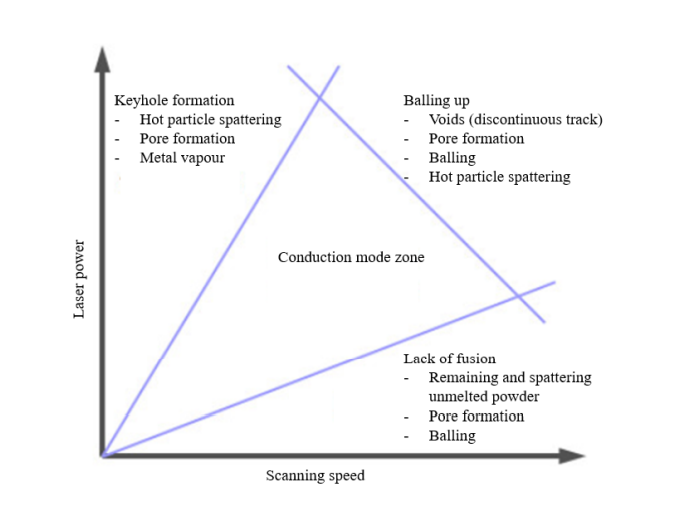In the recently published ‘Effect of the Most Important Parameters on Properties of Inconel 719 Manufactured by Laser Powder Bed Fusion,’ Finnish researcher and thesis student Kalle Kohtanen attempts to uncover the effects of parameters on Inconel 719, produced via laser powder bed fusion.

The global sales of AM services and products, when all AM technologies are considered (mod. Wohlers 2019, p. 164.)
Here, Kohtanen has comprised substantial data to work with while investigating Inconel 718 and learning more about the parameters of laser power bed fusion as well as phenomena such as keyhole formation, conduction mode, lack of fusion, and balling up.
With the project running from January of 2018 through the end of December 2020, Kohtanen wrote this thesis in partnership with the Etteplan company and researchers from Laser Materials Processing of LUT with Metal 3D Innovations (Me3DI) project.
L-PBF manufacturing requires only several simple steps, repeated over and over depending on material and how many layers were established during slicing.
After each printing cycle, powder can usually be recycled, making the L-PBF process very attractive in terms of lack of waste.
Inconel encompasses a family of nickel alloys produced by Special Metals Corporation, with Inconel 718 acting as one particular alloy in the line. Inconel 718 is in fact, a ‘superalloy’ because of its mechanical properties, and shows potential for applications in areas such as gas turbines, cladding, and even aerospace; however, it does leave room for improvement, according to the author, because of its high shear strength. This material is also considered to have inferior thermal conductivity and low rate of material removal. Such challenges mean that affordability can be an issue, along with use of energy.
“Because the conventional machining is not effective, Inconel 718 is more often used in L-PBF process as PBF is tool-free process,” states Kohtanen.
Numerous alloying components make up Inconel 718, to include nickel, chromium, and iron, primarily. Around 110 parameters affect L-PBF overall, leaving them to be categorized in different ways. Laser beam and material interaction model define these parameters in terms of location and interaction.

Overview of the harmful defects in the different laser beam and material
interaction zones (mod. Saunders 2017)
“Main input parameters when Inconel 718 is manufactured by L-PBF have direct effect on characteristics of melt pool. If melt pool loses its stability and starts to roil and spattering, different kind of defects start to occur, such as balling and porosity formation,” explained the author in conclusion, who focused on volumetric energy density, VED, which combines in calculation scanning speed, laser power, hatch spacing and layer thickness.
“Large value of VED (with high laser power and low scanning speed) causes porosity formation into previous molten layers and hot metal particle spattering. This laser beam and material interaction mode is keyhole effect mode. Lack of fusion interaction mode occurs when low VED values are used. In this mode, the molten layers do not form a bond between each other because the melt pool is too tiny. Also, because all the powder does not melt, some unmolten powder remains on between the layers. Because 37 of those defects, lack of fusion results a significant drop in tensile properties and high porosity rate and surface roughness.”
The science of materials is critical to refining 3D printing—and researchers around the world are heavily engaged in research, development, and experimentation—from new developments with Inconel to handling support removal with metal prints, and producing other superalloys.
What do you think of this news? Let us know your thoughts! Join the discussion of this and other 3D printing topics at 3DPrintBoard.com.
[Source / Images: ‘Effect of the Most Important Parameters on Properties of Inconel 719 Manufactured by Laser Powder Bed Fusion’]Subscribe to Our Email Newsletter
Stay up-to-date on all the latest news from the 3D printing industry and receive information and offers from third party vendors.
Print Services
Upload your 3D Models and get them printed quickly and efficiently.
You May Also Like
Johns Hopkins University Researchers Develop HyFAM Technology
Two scientists from Johns Hopkins University, Nathan C. Brown and Jochen Mueller, have developed a hybrid manufacturing technology they call HyFam, or Hybrid Formative Additive Manufacturing. Their work on this technology...
3D Printing G-Code Gets an Upgrade: T-Code
Good old G-Code still manages many 3D printers, great and small. Just like the STL, it’s a standard that enables collaboration while also holding the additive manufacturing (AM) industry back....
AM Rewind: The Biggest News and Trends of 2024
After a sluggish 2023, driven by persistent inflation and geopolitical tensions, 2024 has seen some recovery. Economic growth climbed from about 2.8 percent in 2023 to a modest 3.2 percent...
Metal Wire 3D Printer OEM ValCUN Announces Plans for 2025 Expansion
ValCUN, a Belgian original equipment manufacturer (OEM) of wire-based metal additive manufacturing (AM) hardware, has announced that the company has entered the next phase of its growth trajectory, making key...




































